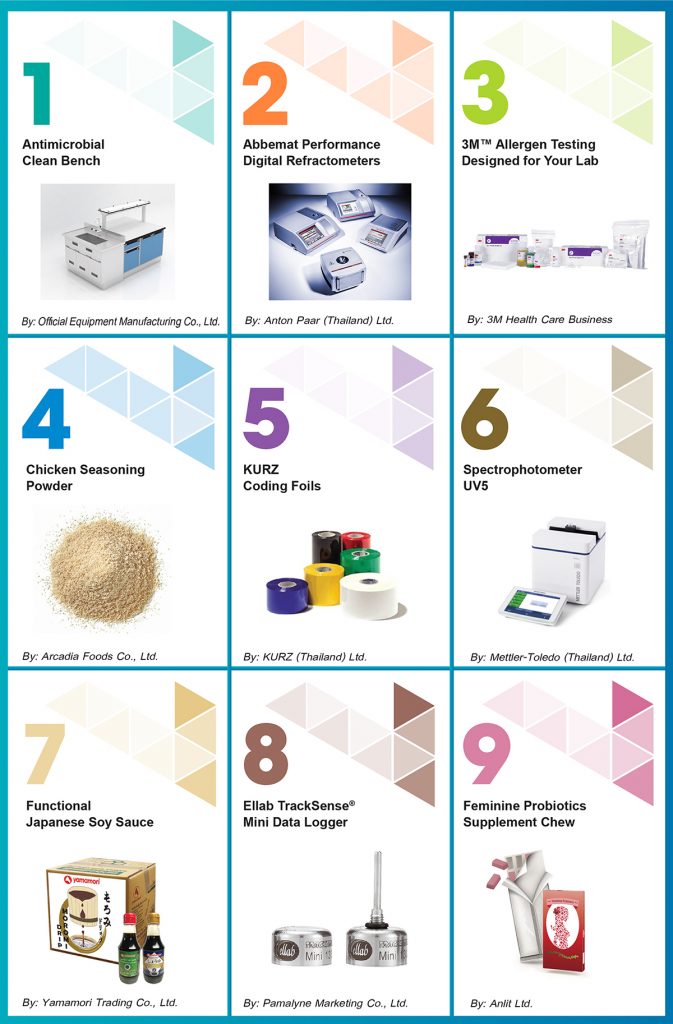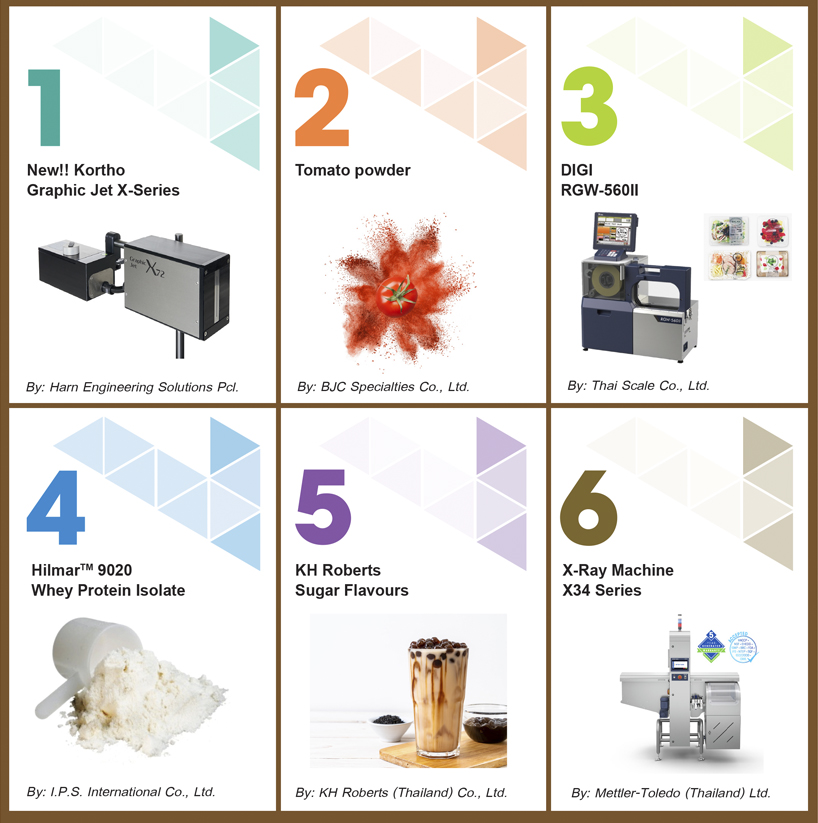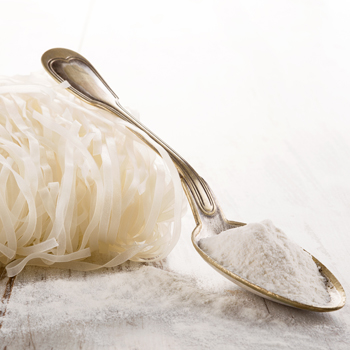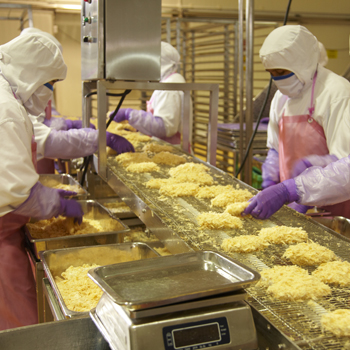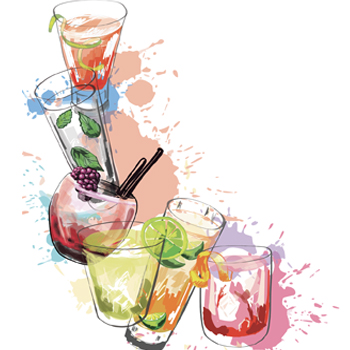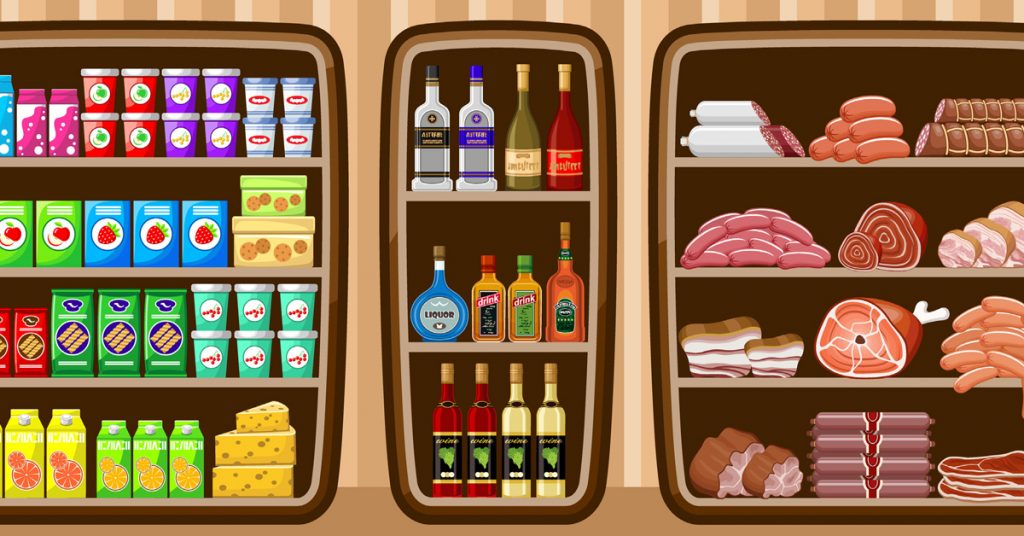
Category: What’s In
See What’s New in the Star Items August 2019
Method Validation Guidelines for Chemical Analysis of Food Matrix as Requirement of ISO/IEC17025
See What’s New in the Star Items July 2019
พบกับผลิตภัณฑ์ดาวเด่น เช่น เครื่องจักร อุปกรณ์ในห้องปฏิบัติการทางวิทยาศาสตร์ ส่วนผสมอาหาร และอื่นๆ ที่น่าสนใจ…ได้ที่นี่ CLICK
How to Produce the High Quality Dried Rice Noodles
การผลิตเส้นก๋วยเตี๋ยวอบแห้งที่มีคุณภาพดี
โดย: ผู้ช่วยศาสตราจารย์ ดร.สาวิตรี รัตนสุมาวงศ์
Assistant Professor Savitree Ratanasumawong, D.M.S.
Department of Food Science and Technology
Faculty of Agro-Industry, Kasetsart University
fagistt@ku.ac.th
ก๋วยเตี๋ยวเป็นผลิตภัณฑ์อาหารเส้นที่ทำจากข้าวที่นิยมรับประทานในประเทศไทยและประเทศในแถบเอเชีย เส้นก๋วยเตี๋ยวที่ดีต้องมีสีขาว มีความเหนียว นุ่ม ไม่มีกลิ่นอับ
ในประเทศไทยนิยมบริโภคก๋วยเตี๋ยวทั้งในรูปของเส้นสด ได้แก่ ก๋วยเตี๋ยวเส้นใหญ่ และเส้นกึ่งแห้ง ได้แก่ก๋วยเตี๋ยวเส้นเล็ก ส่วนเส้นก๋วยเตี๋ยวอบแห้งนั้นนิยมส่งออกขายไปยังต่างประเทศ เนื่องจากมีน้ำหนักเบาและมีอายุการเก็บรักษาที่นานนับปี ในปัจจุบันความต้องการเส้นก๋วยเตี๋ยวอบแห้งในต่างประเทศเพิ่มขึ้นอย่างต่อเนื่องจากการเติบโตของตลาดผลิตภัณฑ์ปราศจากกลูเตน เนื่องจากเส้นก๋วยเตี๋ยวทำจากข้าวเป็นหลักจึงปราศจากกลูเตนโดยธรรมชาติ อย่างไรก็ตาม การปรุงเส้นก๋วยเตี๋ยวอบแห้งต้องใช้เวลานานในการคืนรูป และเนื้อสัมผัสของเส้นที่แข็งกว่าเส้นสด นอกจากนี้ยังมักพบปัญหาความสม่ำเสมอของเส้น อันเนื่องมาจากความแปรปรวนของวัตถุดิบและกระบวนการผลิต ดังนั้น เพื่อให้ได้เส้นก๋วยเตี๋ยวที่มีคุณภาพดีจึงจำเป็นที่จะต้องควบคุมทั้งคุณภาพของวัตถุดิบและกระบวนการผลิตตามหลักการทางวิทยาศาสตร์ ดังนี้
1. วัตถุดิบ
ก) ข้าว: ควรเลือกใช้ข้าวพันธุ์ที่มีปริมาณแอมิโลสสูงมากกว่าร้อยละ 25 ขึ้นไป เนื่องจากแอมิโลสเป็นองค์ประกอบที่สำคัญที่เป็นโครงสร้างหลักของเส้นและทำให้เส้นเกิดความยืดหยุ่น อย่างไรก็ตาม ข้าวแต่ละพันธุ์ถึงแม้จะมีปริมาณแอมิโลสใกล้เคียงกัน แต่ก็อาจให้ลักษณะเนื้อสัมผัสของเส้นที่แตกต่างกันได้ เนื่องจากปัจจัยอื่นในข้าวที่แตกต่างกัน เช่น โครงสร้างละเอียดของสตาร์ช หรือปริมาณโปรตีน สำหรับปริมาณโปรตีนในข้าวควรมีปริมาณต่ำ เพื่อให้ได้เส้นก๋วยเตี๋ยวที่นุ่มและผิวไม่กระด้าง นอกจากนี้ อายุของข้าวที่นำมาใช้ก็มีผลต่อความแข็งและความยืดหยุ่นของเส้นก๋วยเตี๋ยว โดยปกติควรใช้ข้าวเก่าที่มีอายุตั้งแต่ 4 เดือนขึ้นไป แต่ไม่ควรเกิน 12 เดือน (Ratanasumawong, 2016) อย่างไรก็ตาม ในความเป็นจริงข้าวที่ใช้ผลิตเส้นก๋วยเตี๋ยวมักเป็นข้าวหักซึ่งมีการผสมกันของข้าวหลายพันธุ์ รวมถึงอายุของข้าวที่นำมาสีอาจจะแตกต่างกัน ทำให้เกิดความแปรปรวนของคุณภาพของเส้นก๋วยเตี๋ยว หากสามารถควบคุมความแปรปรวนในส่วนนี้ได้ก็จะทำให้ได้เส้นก๋วยเตี๋ยวที่มีคุณภาพสม่ำเสมอมากขึ้น
Rice noodles are among many rice products popular in Thailand and many Asian countries. Good quality rice noodles possess white in color, elastically soft, and musty-free.
Among Thais, rice noodles are preferred in their various sizes and forms, ranging from the freshly made kind such as wide rice noodles (sen-yai), to the semi-dried kind, such as rice stick noodles (sen-lek). Dried rice noodles, though, are more preferable as exports, due to their light weight and longer shelf life. At present, the demand for dried rice noodles in foreign countries has been constantly increasing as a result of an ever-growing market for gluten-free products. Made mainly from rice flour, rice noodles are naturally gluten-free. However, when cooking, certain length of time is required to cook the dried noodles back to their original texture, which is understandably harder than that of fresh noodles. Another problem found, regarding dried noodles, is the inconsistency of the noodle strands, which is the result of the variability of raw materials and production process. In order to get good quality noodles, then, controls on raw materials quality and production process have to be closely monitored.
1. Raw Materials
A) Rice: Use only rice varieties that contain 25% of amylose or greater. Amylose is the integral part that constitutes noodles’ main structure and elasticity. However, even rice varieties that have almost similar percentage of amylose can yield noticeably different texture to the noodles, owing to other particular factors in the rice itself, such as fine structure of starch, and its protein content. Preferably, rice used in noodles production should contain low percentage of protein so that the resulting noodles have soft and smooth texture. Another factor affecting the hardness and elasticity of noodles is the age of rice. The optimum age of rice used in making good noodles should be within 4-12 months old (Ratanasumawong, 2016) However, in normal practice, rice used in making noodles is mostly broken and a mixture of wide varieties and ages which triggers to the inconsistency of noodles quality. If these variances can be effectively controlled, noodles produced will be of consistent quality.
Renewable Energy and Alternative Energy
พลังงานทดแทนและพลังงานทางเลือก
โดย: กรมพัฒนาพลังงานทดแทนและอนุรักษ์พลังงาน
กระทรวงพลังงาน
Department of Renewable Energy Development and Energy Efficiency
Ministry of Energy
กระทรวงพลังงานได้วางกรอบแผนบูรณาการพลังงานแห่งชาติ ที่ให้ความสำคัญใน 3 ด้าน ประกอบด้วย ด้านความมั่นคงทางพลังงาน ด้านเศรษฐกิจ และด้านสิ่งแวดล้อม โดยในแผนบูรณาการพลังงานแห่งชาติ กระทรวงพลังงานได้ทบทวนการจัดทำแผนพลังงาน 5 แผนหลักในช่วงปี พ.ศ.2558-2579 ที่สอดคล้องกับรอบของการจัดทำแผนพัฒนาเศรษฐกิจและสังคมแห่งชาติ ซึ่งหนึ่งในแผนพลังงาน 5 แผนหลัก คือ แผนพัฒนาพลังงานทดแทนและพลังงานทางเลือก (Alternative Energy Development Plan; AEDP2015)
การพัฒนาพลังงานทดแทนในประเทศไทยเพิ่มขึ้นอย่างต่อเนื่อง เป็นผลมาจากนโยบายส่งเสริมการผลิตการใช้พลังงานทดแทน โดยการใช้งานจะอยู่ในรูปของพลังงานไฟฟ้า พลังงานความร้อน และเชื้อเพลิงชีวภาพ ในปี 2557 ประเทศไทยมีการใช้พลังงานทดแทนทั้งสิ้น 9,025 พันตันเทียบเท่าน้ำมันดิบ (ktoe) เพิ่มขึ้นจากปีก่อนร้อยละ 9.6 หรือคิดเป็นร้อยละ 11.9 ของการใช้พลังงานขั้นสุดท้าย โดยการใช้พลังงานทดแทนจะอยู่ในรูปของพลังงานความร้อนมากที่สุด คิดเป็นสัดส่วนมากกว่าร้อยละ 60 ของการใช้พลังงานทดแทนทั้งหมด รองลงมา ได้แก่ เชื้อเพลิงชีวภาพ และไฟฟ้า โดยในปี 2557 การใช้พลังงานความร้อน คิดเป็นร้อยละ 64 เชื้อเพลิงชีวภาพ และไฟฟ้า คิดเป็นร้อยละ 19.7 และ 16.3 ตามลำดับ
Ministry of Energy has developed the Thailand Integrated Energy Blueprint (TIEB) with focus on energy security, economy and ecology. In the TIEB, Ministry of Energy has reviewed five energy master plans during the year 2015-2036 in consistent with the national economic and social development plan. One of the five master plans is the Alternative Energy development Plan (AEDP2015).
The development of renewable energy in Thailand increased steadily. It was a result of the government promotion policy. Productions of renewable energy are in the form of electricity, heat and biofuels. In 2014, the total renewable energy consumption was at 9,025 thousand tons of oil equivalent (ktoe), up 9.6% from the previous year. It shares at 11.9% of final energy consumption. The renewable energy is highly consumed in the form of heat. It is about 60% of the total renewable energy consumption, followed by biofuels and electricity. In 2014, the utilization of renewable energy in the form of heat, biofuel and electricity are 64%, 19.7%, and 16.3% of total renewable energy consumption, respectively.
Novel Processing Technologies for Liquid Foods
Translated and Compiled By:
กองบรรณาธิการ
นิตยสาร ฟู้ด โฟกัส ไทยแลนด์
Editorial Team
Food Focus Thailand Magazine
editor@foodfocusthailand.com
จากความต้องการของผู้บริโภคที่หันมาใส่ใจในสุขภาพกันมากขึ้น โดยเน้นการบริโภคอาหารที่มีความสดใหม่ คุณภาพสูง และดีต่อสุขภาพ ทั้งยังต้องปราศจากวัตถุกันเสีย และปลอดภัยต่อการบริโภค ล้วนส่งผลให้นวัตกรรมของเทคโนโลยีในกระบวนการผลิตเป็นที่ต้องการในอุตสาหกรรมอาหาร
นอกจากนี้ จากกระแสรักสุขภาพ การใช้ส่วนผสมต่างๆ ไม่ว่าจะเป็น สี กลิ่นรส หรือวัตถุกันเสียที่มาจากธรรมชาติยังเป็นส่วนกระตุ้นให้เกิดการวิจัยด้านนวัตกรรมการผลิตอาหารที่มีประสิทธิภาพในการทำลายจุลินทรีย์ ในขณะเดียวกันต้องรักษาคุณสมบัติและคุณประโยชน์ของส่วนผสมที่มาจากธรรมชาติ และคงคุณลักษณะ คุณภาพ และคุณค่าทางโภชนาการของผลิตภัณฑ์อาหารไว้ได้อีกด้วย
การปรับปรุงคุณภาพอาหารให้ดีขึ้นเป็นเป้าหมายหลักของการผลิตอาหารและเครื่องดื่ม นวัตกรรมการผลิตอาหาร เช่น กระบวนการความดันสูง (High Pressure Processing; HPP) สนามไฟฟ้าแบบพัลส์ (Pulsed Electric Field; PEF) และพลาสมาเย็น จึงเป็นเทคโนโลยีที่มีแนวโน้มและมีศักยภาพที่จะนำไปประยุกต์ใช้ในอุตสาหกรรมอาหารต่อไป
The need for novel processing technologies in the food industry is a direct result of consumer demand for fresh, high quality and healthy products that are free from chemical preservatives and yet are safe.
The trend towards the use of “natural” ingredients, (colors, flavors or preservatives) although technically challenging, has created the need for research into milder and more energy efficient but equally effective processing technologies that are able to preserve the structure and thus, function and benefits of novel ingredients whilst at the same time maintaining the nutritional and other food product qualities.
Improvement of product quality has always been the main goal of food and beverage manufacturers. Novel processing technologies such as high-pressure processing (HPP), pulsed electric field (PEF) and cold plasma are thought to be among the most promising of novel technologies.
Food Safety: Process Control and Cleaning Practice
ความปลอดภัยของอาหาร: การควบคุมกระบวนการผลิตและการล้างทำความสะอาด
โดย: สุดารัตน์ ฉายโฉมเลิศ
Sudarat Chaichomlert
Professional of Virus and Serology
Betagro Science Center Co., Ltd.
sudaratc@betagro.com
ผู้บริโภคในประเทศที่พัฒนาแล้วมีความตื่นตัวในเรื่องสุขภาพและความปลอดภัยของอาหาร เพราะอันตรายในอาหารเป็นสิ่งที่มองไม่เห็นและไม่สามารถสัมผัสได้ แต่อาจมีโทษต่อร่างกายถึงแก่ชีวิต ดังนั้นจึงมีการนำมาตรฐาน GMP และ HACCP มาใช้ในการควบคุมการผลิต
มาตรฐานความปลอดภัยทางอาหาร หรือ HACCP เป็นหัวใจสำคัญเพื่อให้การผลิตอาหารเป็นไปตามมาตรฐาน โดยเฉพาะอย่างยิ่งมาตรฐานความปลอดภัยอาหารโลก Global Food Safety Initiative (GFSI) ซึ่งไม่เพียงแต่ความสะอาดปลอดภัยของเครื่องมือ ชิ้นส่วน วัตถุดิบเท่านั้น การทำความสะอาดเครื่องมือและอุปกรณ์ที่เกี่ยวข้องอย่างถูกวิธีถือเป็นส่วนสำคัญอย่างมากสำหรับการดำเนินธุรกิจ นอกเหนือจากความสะอาดและความปลอดภัยของผู้บริโภคแล้วยังสามารถยืดอายุของสินค้าที่วางจำหน่าย (Shelf life) ได้อีกด้วย
In developed countries, consumers are wide-awake of health and food safety. For the reason that food hazards are invisible to the eye or contacted, but could be fatal to the body, GMP and HACCP standards therefore are used to control the production process.
Food safety standards or HACCP is a key for food production in compliance with standard requirements, especially the Global Food Safety Initiative (GFSI). Not only sanitizing equipment, parts, and raw materials stands safe and sound, but a proper cleaning process of such tools and related equipment is also a very important part of food business operations. To become more than cleanliness and safety of consumers, it can also extend the shelf life of finished products.
What should we know about aroma and flavor for application purposes in foods?
เรื่องที่เราควรรู้เกี่ยวกับกลิ่นและกลิ่นรสเพื่อการนำไปประยุกต์ใช้ในอาหาร
โดย:
ผู้ช่วยศาสตราจารย์ ดร.อินทาวุธ สรรพวรสถิตย์
Assistant Professor Inthawoot Suppavorasatit, Ph.D.
Department of Food Technology, Faculty of Science, Chulalongkorn University
Deputy Dean, School of Agricultural Resources, Chulalongkorn University
ในโลกของการตลาด กลิ่นและกลิ่นรสถือเป็นสิ่งสำคัญเนื่องจากเป็นปัจจัยแรกๆ ที่ผลักดันให้เกิดการยอมรับผลิตภัณฑ์ได้ ซึ่งหากกลิ่นหรือกลิ่นรสไม่ดีเพียงพอ ผู้บริโภคอาจจะตัดสินใจที่จะไม่กลืนอาหารนั้น หรือเลือกที่จะไม่ซื้อ หรือเมื่อซื้อไปแล้วอาจจะไม่ซื้ออีกก็เป็นได้
รู้หรือไม่ว่า…กลิ่นและกลิ่นรสนั้นไม่เหมือนกัน เมื่อพูดถึงการรับรู้ของมนุษย์ กลิ่นและกลิ่นรสมีความแตกต่างกันอย่างชัดเจน การรับรู้กลิ่นจะใช้จมูก แต่การรับรู้กลิ่นรสจะเกิดขึ้นเมื่อนำอาหารเข้าปากไปแล้วเท่านั้น โดยระหว่างกลืนอาหาร สารระเหยให้กลิ่นรสจะระเหยผ่านขึ้นไปโพรงจมูกระหว่างที่เราหายใจออก หรือจะเรียกกลิ่นรสอีกอย่างได้ว่า กลิ่นที่ได้รับผ่านทางการกินอาหาร ดังนั้น เมื่อกล่าวถึงการรับรู้กลิ่นรส จะหมายถึง การรับรู้ที่มีการรวมองค์ประกอบของทั้งกลิ่น รสชาติ และความรู้สึกอื่นๆ ที่เกิดขึ้นภายในปากระหว่างการรับประทาน เช่น ความร้อน ความเย็น ความเจ็บปวด และอื่นๆ และเมื่อพูดถึงคำนิยามของคำว่ากลิ่นและกลิ่นรสนั้น อาจจะมีคำนิยามได้เป็น 2 นิยามหลักๆ โดยขึ้นกับมุมมองของผู้ให้คำนิยามนั้น ผู้ผลิตอาหารจึงมีความจำเป็นที่จะต้องพิจารณาความเปลี่ยนแปลงที่อาจเกิดขึ้นระหว่างกระบวนการแปรรูป หรือการสร้างกลิ่นหรือกลิ่นรสระหว่างกระบวนการแปรรูปและการเตรียมอาหาร
In the world of food marketing, aroma and flavor of foods are important since they are driving force of acceptability of the products. If the aroma or flavor are not good enough, consumer might decide not to ingest or not to buy the product or buy it just only one time, no second time.
Do you know that aroma and flavor are difference? In term of perception, aroma and flavor are totally difference. Aroma is perceived by nose. On the other hands, flavor is perceived after the food is put in the mouth, the volatile flavor compounds are vaporized through nasal cavity during exhale (aroma by mouth). Therefore, the perception of flavor is the combination of aroma, taste, and sensation (e.g. hot, cold, pain, and others) in the mouth during consumption. In term of definitions of aroma and flavor depend on definer’s viewpoints. Food producers need to consider the changes that may be happened during processing or the formation of aroma or flavor during processing and preparation.
Sparkling Idea 12 Best Low-Calorie Beers
ชนแก้วแล้วเติมไอเดียกับ 12 เบียร์แคลอรีต่ำจากทั่วโลก
By: Tiffany Ayuda
Compiled and Translated By: กองบรรณาธิการ
นิตยสาร ฟู้ด โฟกัส ไทยแลนด์
Editorial Team
Food Focus Thailand Magazine
editor@foodfocusthailand.com
ไม่ว่าคุณจะเป็นคอเบียร์ที่ชอบเบียร์กลิ่นหอมหวานของดอกไม้ในแบบฉบับเบียร์ที่ผลิตและส่งออกสมัยแรกๆ หรือที่เรียกกันว่าเบียร์ IPA หรือว่าจะหลงใหลเบียร์ที่ปรุงแต่งกลิ่นรสด้วยผลไม้ เราได้รวบรวมไอเดียตัวอย่างเบียร์ที่มีปริมาณแคลอรีต่ำซึ่งมีรสชาติยอดเยี่ยมที่สุดมาไว้ให้แล้ว รับรองว่าเบียร์เหล่านี้ดีต่อสุขภาพและไม่ทำให้อ้วนลงพุงแน่นอน
หากคุณกำลังมองหาเบียร์แคลอรีต่ำให้มองหาเบียร์ที่มีปริมาณแอลกอฮอล์อยู่ระหว่างร้อยละ 4-5 โดยปริมาตร โดยเลือกไลท์เบียร์ที่มีปริมาณแอลกอฮอล์ไม่ต่ำกว่าร้อยละ 4 เพราะเบียร์อะไรก็ตามที่มีปริมารแอลกอฮอล์ต่ำกว่านี้จะเหมือนกับว่าคุณได้ลิ้มรสชาติของน้ำเปล่าเลยทีเดียว คุณสามารถหาเบียร์ที่มีรสชาติดีขึ้นมาอีกหน่อยได้ในปริมาณแอลกอฮอล์ที่แนะนำต่อไปนี้ซึ่งให้พลังงานอยู่ที่ 95-120 แคลอรีต่อเบียร์ 1 กระป๋อง ตามปริมาณหนึ่งหน่วยบริโภคที่ 12 ออนซ์
Miller Lite
ในฐานะที่เป็นเบียร์พิลส์เนอร์ซึ่งจัดเป็นเบียร์ที่มีปริมาณแคลอรีน่าคบอยู่แล้ว Miller Lite ได้รับการออกแบบมาเพื่อให้ดื่มง่าย ผลิตจากข้าวบาร์เลย์ มอลต์ เพื่อผสานสมดุลกลิ่นฮอปส์กับความหอมของดอกไม้และผลไม้ เบียร์ที่ผลิตได้มีสีทองเข้ม ดื่มแล้วปลุกความสดชื่น ไม่มีแอลกอฮอล์มากเกินไป และแน่นอนว่าเรื่องปริมาณแคลอรีนั้นสบายใจได้
Whether you love the floral notes in an IPA or savor the fruitiness in a sour, we rounded up the best-tasting, low-calorie beers out there that’ll give you a healthy buzz and won’t leave you with a beer gut.
If you’re looking for lower-calorie beer, look for ones that are between 4 and 5 percent alcohol by volume (ABV). Sticking with light beer no less than 4 percent ABV because anything lower tends to taste too watered down. You can generally find a few good tasting beers around 95 to 120 calories per 12-ounce serving at this ABV level.
Miller Lite
As the all-time, calorie-friendly pilsner, Miller Lite is designed for easy drinking. It’s brewed with barley malt to balance the floral, fruity flavors in hops and give it a deep golden hue. Refreshingly crisp—and not too yeasty—this calorie-conscious brew checks all of our boxes.
